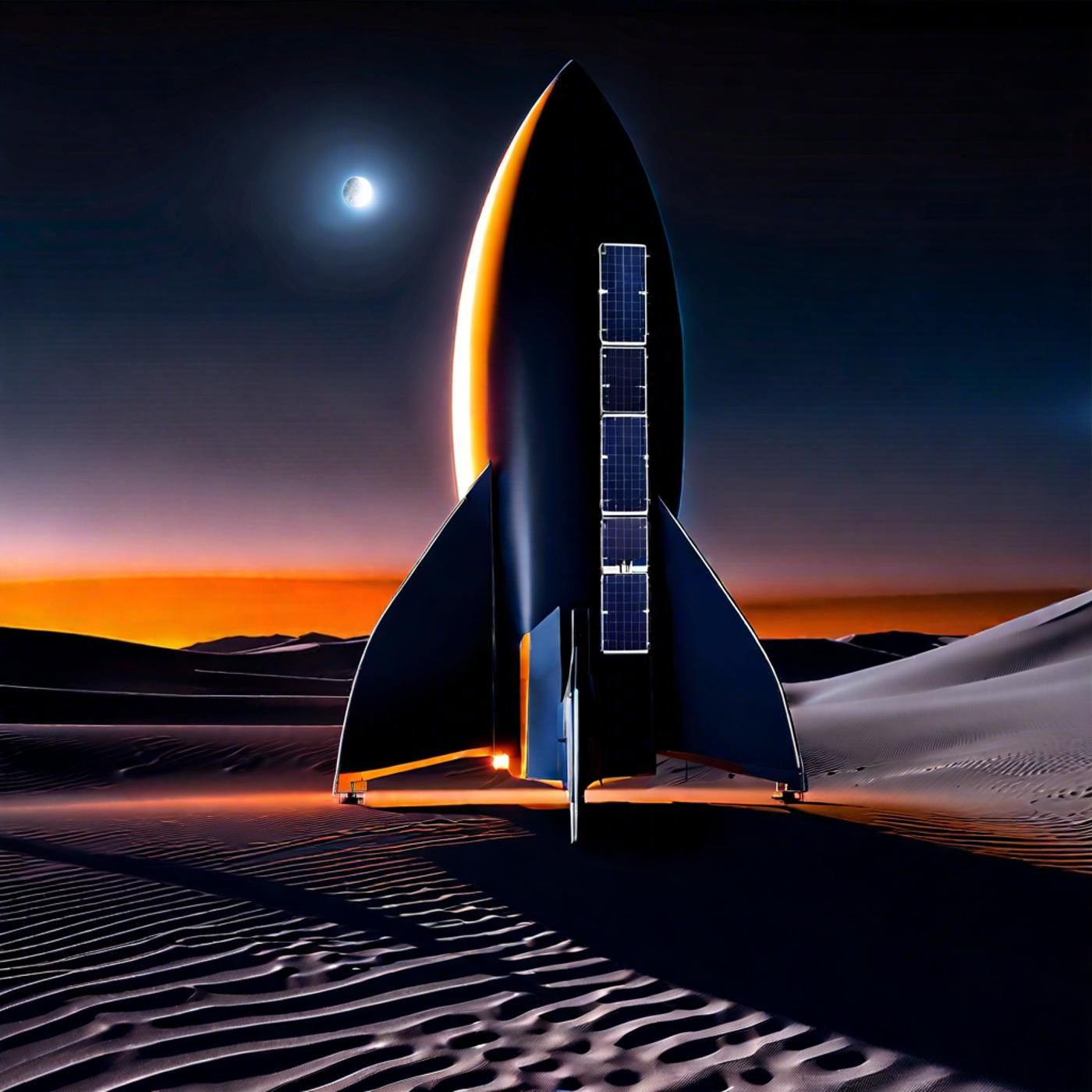S03E128: Extending Starliner ISS Mission, Terraforming Mars, and Perseverance's Ascent
Welcome to Astronomy Daily, your go-to Podcast for the latest news in space and Astronomy. I'm your host, Anna. Today, we have an exciting lineup of stories to share with you. We'll dive into NASA's decision-making process on whether to extend...
Welcome to Astronomy Daily, your go-to Podcast for the latest news in space and Astronomy. I'm your host, Anna. Today, we have an exciting lineup of stories to share with you. We'll dive into NASA's decision-making process on whether to extend astronauts' stay aboard the International Space Station amidst ongoing issues with the Boeing Starliner capsule. We'll also explore a groundbreaking new method developed by researchers to terraform Mars using engineered nanoparticles, a technique that could make the red planet more hospitable for future colonists. We'll also look at NASA's Perseverance rover as it embarks on a challenging new mission to climb the western rim of Jezero Crater in search of ancient life signs. Lastly, we'll shed light on a fascinating project by Honeybee Robotics to install massive streetlights on the moon, which could revolutionize future lunar exploration. Stay tuned as these stories promise to be out of this world.
- **NASA's ISS Dilemma with Boeing Starliner**: NASA is currently in a critical decision phase, determining the fate of two astronauts stationed aboard the International Space Station.
- **Terraforming Mars with Engineered Nanoparticles**: Researchers from the University of Chicago and Northwestern have unveiled a revolutionary approach to warming Mars, potentially making the red planet more conducive to life. Their method involves using engineered dust particles to increase Mars' temperature by over 50 degrees Fahrenheit.
- **Perseverance Rover's New Mission**: Speaking of Mars, NASA's Perseverance rover is gearing up to tackle one of its toughest challenges yet—climbing the western rim of Jezero Crater. This ascent marks the start of its fifth science campaign since it touched down on the red planet in February 2021.
- **Honeybee Robotics' Lunar Streetlights**: Finally, Honeybee Robotics has put forward a fascinating proposal to help illuminate the long, dark lunar nights with massive streetlights. This project, known as Lunar Saber, aims to construct 330-foot tall towers on the moon that will store solar energy and provide powerful floodlight illumination during the lunar nights, which last the equivalent of two Earth weeks.
For more Astronomy Daily, including our continually updating newsfeed, visit our website at astronomydaily.io. Follow us on social media at AstroDailyPod on Facebook, X, YouTubeMusic, and TikTok. We love engaging with our community, so be sure to drop us a message or comment on your favorite platform.
For more Space and Astronomy News Podcasts, visit our HQ at www.bitesz.com.
Become a supporter of this podcast: https://www.spreaker.com/podcast/astronomy-daily-the-podcast--5648921/support.
This podcast features the latest news in space and astronomy
Anna: Welcome to Astronomy Daily, your go to Podcast for the latest news in space and Astronomy. I'm your host, Anna. Today, we have an exciting lineup of stories to share with you. We'll dive into NASA's decision making process on whether to extend astronauts stay aboard the International Space Station amidst, ongoing issues with the Boeing Starliner capsule. We'll also explore a groundbreaking new method developed by researchers to terraform Mars using engineered nanoparticles, a, technique that could make the red planet more hospitable for future colonists. Additionally we'll look at NASA's Perseverance rover as it embarks on a challenging new mission to climb the western rim of Jezero Crater in search of ancient life signs. Lastly, we'll shed light on a fascinating project by honeybee Robotics to install massive streetlights on the moon, which could revolutionize future lunar exploration. Stay tuned as these stories promise to be out of this world.
NASA considering alternative plan to return astronauts via SpaceX's Dragon capsule
NASA is currently in a critical decision phase, determining the fate of two astronauts stationed aboard the International Space Station. Originally expected to be away only for a short stint, Butch Wilmore and SUNY Williams have found their mission extended much longer than anticipated due to complications with Boeing's Starliner capsule. The spacecraft faced numerous challenges, including thruster failures and helium leaks, which have cast doubt on its ability to safely bring the astronauts back to Earth. In light of these issues, NASA is considering an alternative plan, having Wilmore and Williams return via SpaceX's dragon capsule. This would mean their mission could extend until early next year, potentially adding several more months to their time on board the ISS. It's worth noting that SpaceX's dragon has a strong track record since its first manned mission in 2020, making it a reliable option for NASA. The decision to switch to SpaceX, however, isn't straightforward. It would necessitate reshuffling the upcoming crew assignments as, uh, SpaceX's next flight is already set for late September. With its own planned crew, Wilmore and Williams would need to replace two astronauts on this mission to secure their seats home. Additionally, the ISS's limited docking capacity means that Boeing's Starliner would have to vacate its spot to allow the dragon capsule to dock. Despite Boeing's reassurances that the Starliner can still perform a safe return trip, NASA is taking a cautious approach, prioritizing comprehensive data analysis to ensure crew safety. Given the mixed history with Boeing's earlier unmanned test flight, which required extensive fixes costing over a billion dollars, NASA is wary of rushing any decisions. This prolonged deliberation underscores NASA's commitment to ensuring no stone is left unturned.
Scientists use engineered dust particles to increase Mars temperature, potentially fostering microbial life
Valuing thorough analysis and safety above all, researchers from the University of Chicago and northwestern have unveiled a, uh, revolutionary approach to warming Mars, potentially making the red planet more conducive to life. Their method involves using engineered dust particles to increase Mars temperature by over 50 degrees fahrenheit. This significant temperature rise could create conditions favorable for microbial life, marking a critical step toward making Mars habitable for future human colonization. What sets this approach apart is its impressive efficiency. By using resources already available on Mars, researchers have found a way that's 5000 times more effective than previous terraforming proposals. Rather than importing materials from Earth or mining rare resources on Mars, this strategy smartly leverages what Mars naturally offers. The particles are designed to trap escaping heat and scatter sunlight toward the martian surface, enhancing its greenhouse effect. According to Edwin Keith, a UH professor of geophysical sciences at the University of Chicago, this method suggests that the barriers to warming Mars to allow liquid water are not as high as previously thought. While there is still a long way to go before humans can walk on Mars unaided, this breakthrough brings us closer to transforming Mars into a world where life can begin to thrive. One scientifically thrilling step at a time.
NASA's Perseverance rover is gearing up for its fifth science campaign
Speaking of Mars, NASA's Perseverance rover is gearing up to tackle one of its toughest challenges yet, climbing the western rim of Jezero Crater. This uh, ascent marks the start of its fifth science campaign since it touched down on the red planet in February 2021. After spending over two and a half years exploring the crater's floor and its river delta, Perseverance is ready to take on some of the steepest and most challenging terrains it has encountered to date. The new mission, set to begin the week of August 19, will see the rover navigating slopes as, uh, steep as 23 degrees, using its advanced auto navigation capabilities to avoid hazards. The team has carefully planned a route that balances safety with scientific discovery, ensuring that Perseverance can continue its groundbreaking work without interruption. At the top of Gezero Crater, the rover will explore two priority regions, Pico Turquino and Witch Hazel Hill. These areas are of significant interest to scientists because they may offer clues about Mars ancient history. Pico Turquino, for instance, has fractures that might have been caused by hydrothermal activity, an intriguing hint of the planet's past geological processes. Meanwhile, witch Hazel Hill features layered materials that date back to an era when Mars had a much different climate, possibly even harboring life. During its river delta exploration, Perseverance collected 22 rock cores, some of which contain sedimentary rock, the only samples of their kind ever gathered from another planet. These rocks are vital for understanding the history of water on Mars and could even provide evidence of ancient microbial life. As, uh, the rover ascends to new heights, scientists are eager to see what additional secrets Mars may reveal.
Honey bee robotics propose to illuminate lunar nights with massive streetlights
And finally for today, honey bee robotics has put forward a fascinating proposal to help illuminate the long, dark lunar nights with massive streetlights. This project, known as Lunar Saber, aims to construct 330 foot tall towers on the moon that will store solar energy and provide powerful floodlight illumination during the lunar nights, which lasts the equivalent of two Earth weeks. Such a development could be crucial in supporting future human exploration and settlement on the moon. These towering structures aren't just about lighting up the lunar surface, they serve a dual purpose. During the lengthy, sun drenched lunar Daily, these towers will absorb and store solar energy. Once the two weeks of sunlight are over, the towers will switch roles and provide much needed light to withstand the frozen nights, which can be particularly harsh and perilous. This innovation is not only aimed at lighting, but also at potentially recharging lunar rovers and other infrastructure, thus creating a rudimentary power grid on the moon. Honeybee Robotics, part of Jeff Bezos Blue Origin, is leading the charge on this initiative with funding from DARPA, the us government's Defense Advanced Research Projects Agency. Although the project is still in its early development stages here on Earth, it represents one of the pioneering steps toward making the moon more habitable for human settlers. If the lunar saber project can achieve its goals, it could very well become a cornerstone in the infrastructure required for extended lunar missions and even permanent settlements. In summary, the lunar Saber initiative could mark a significant leap forward in our efforts to not only return to the moon, but to stay there. By providing necessary illumination and energy storage capabilities, these colossal streetlights will help ensure that the moon remains a well lit and powered outpost, paving the way for future exploration and possibly even long term human habitation. That's it for today's episode. You've been listening to Astronomy Daily with me. Um, for more updates, visit our website at astronomydaily IO, where you can subscribe to our free Daily newsletter, catch up on all the latest space and Astronomy news with our constantly updating newsfeed, read our blog, and listen to all our back episodes. You can also find us on social media. Just search for AstroDailyPod Daily Pod on Facebook, X, YouTubeMusic, and TikTok. Thanks for tuning in and see you tomorrow. In the meantime, keep looking up
New to Astronomy Daily - The Podcast?
Here are some great episodes to start with.


















